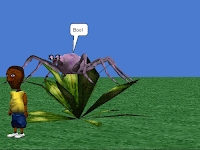

I'm reading the PhD dissertation of Caitlin Kelleher, Motivating Programming: using storytelling to make computer programming attractive to middle school girls, and it's making me think a lot about teaching more intentionally toward the needs and characteristics of the population I work with--middle school girls. I think I already teach application skills and beginning programming with an approach that fosters curiosity, creativity, and risk taking. Kelleher's work shows that girls are much more motivated to tackle the logic and syntax problems of programming if the end result is a story they are telling. I've noticed that many girls will actually create a storytelling environment in which they build and program their Lego robots, and this becomes most fully developed and expressed when they videotape their robots and edit the short videos to share. One pair of girls even turned an assignment about making a switch-operated gate into a hilarious episode of "Pimp My Ride" in which the robotic gate played only a tiny part.
So this year I'll be trying out Storytelling Alice with my 7th graders, hopefully working with their English or writing teachers for content ideas. The idea behind the program is that students program already richly-developed 3D objects by dragging their attribute tiles into an editing space and creating new attributes for them. The illustrations I posted show you what it looks like. You don't see the commands for the spider to say "Boo!" in the code because the spider's entire jump procedure is created as a sub-procedure that isn't shown on that panel.

6 comments :
Hi Erik,
I just came across Storytelling Alice this summer and am interested in using it with students in grade 6/7. I am wondering if you know of any good lesson plans or resources that would help someone with a non-programming background (me) to teach students how to use it effectively.
Thanks!
Kelleher includes a great set of tutorials to teach the basics of the program so if you have your students go through those first they'll have a good idea of how to proceed. The other thing Kelleher suggests is for students to draw their sequence of ideas in storyboard fashion before they make anything so they have a plan to keep them focused. One thing that isn't clear to me is how to make a story switch to another scene. This isn't covered in the tutorials so you might restrict students to one scene unless you can figure it out. Good luck!
Thanks Erik. Where do you find the tutorials? On the storytelling Alice site, there is only a four page brochure which covers some basics of the program. Are the tutorials in Kaitlyn's dissertation paper, or on another website? Can you please advise?
The tutorials are in the program itself. When you run it the first time there's a splash screen that offers to show three tutorials before you start. If you haven't installed the program that takes a bit of work itself. It only works on a PC, not a Mac, and also requires 2 Java programs to render the 3D and multimedia. Those are here (look for "j3d-1_5_2-windows-i586.exe") and here (after clicking download you choose your platform). I was thinking of writing a post about how to install Storytelling Alice. It took me a while to figure out.
Thank you! I am exciting to start trying it out!
Well this is a bit late but I have been trying to teach my daughter to program and so far she is liking Alice. So I can keep ahead of her I did come across this link http://www.aliceprogramming.net/text/book.html I hope this helps.
Post a Comment